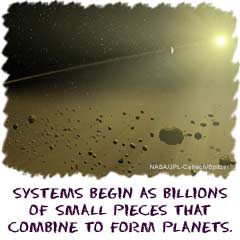|
|
||||||||||||||||
 |
|

|
||||||||||||||
Step By Step Systems don't just appear. It takes billions of years for small pieces of dust to collect and form stars and planets. Every object in the universe has a gravity. It might be the really really tiny gravity of a goldfish or the enormous gravity of a red giant. No matter what the gravity, all objects pull on each other.
Systems don't just appear. It takes billions of years for small pieces of dust to collect and form stars and planets. Every object in the universe has a gravity. It might be the really really tiny gravity of a goldfish or the enormous gravity of a red giant. No matter what the gravity, all objects pull on each other.
Over time, small objects can clump together and form larger ones. These large objects then begin to clump. Soon you might have an asteroid or a collection of ice. Asteroids are pulled together and collide, leaving you with small moons or planetesimals. Eventually you wind up with smaller terrestrial planets or large gas giants. Step by step, gravity pulls objects closer. 4.6 Billion YearsThat's how long ago the Solar System was born. That's what scientists say. While the parts of the Solar System were born at the same time, it wasn't "POOF!" and everything was here. It took billions of years for the entire system to develop. Eventually a star developed and then the eight planets and an asteroid belt between the fourth and fifth planets.Dust In The Solar WindThere was really no solar wind when it all started. There wasn't even a Sun. The Solar System began as a spinning blob of gases. As that blob spun, it began to flatten. It probably looked like that classic shape for a flying saucer. It was a round flattened disk with a bulge in the center. That bulge was the beginning of our Sun. Scientists call that 'baby' sun a protosun. The last step is the magic that ignites the Sun and causes it to shine. Remember all of that dust and gas swirling around? As time passed the disk flattened even more and the planets began to develop. |

|
|||||||||||||||
Useful Reference MaterialsEncyclopedia.com (Planetary Systems):http://www.questia.com/read/1E1-plansys/planetary-system Wikipedia (Planetary Nebula): http://en.wikipedia.org/wiki/Planetary_nebula Encyclopædia Britannica (Extrasolar Planets): http://www.britannica.com/EBchecked/topic/1076150/extrasolar-planet | ||||||||||||||||
|
RETURN TO TOP or Search for more information... * The custom search only looks at Rader's sites. |
|||||||||||||||
©copyright 1997-2015 Andrew Rader Studios, All rights reserved. Current Page: Cosmos4Kids.com | Systems | Evolution of Star Systems |
||||||||||||||||
|
|
||||||||||||||||

